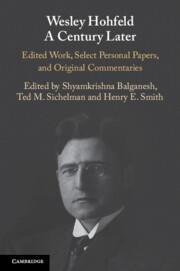Book contents
- Wesley Hohfeld A Century Later
- Wesley Hohfeld A Century Later
- Copyright page
- Contents
- Figures
- Tables
- Contributors
- Introduction: Hohfeld at the Crossroads
- Some Fundamental Legal Conceptions as Applied in Judicial Reasoning
- Selected Personal Papers of Wesley Newcomb Hohfeld
- Part I Philosophy of Jural Relations
- Part II Hohfeld and Property
- 5 Property’s Building Blocks: Hohfeld in Europe and Beyond
- 6 The In Rem/In Personam Distinction and Conceptual Partitioning for Persistence
- 7 Hohfeld and the Theory of In Rem Rights: An Attempted Mediation
- Part III Hohfeld and Equity
- Part IV Hohfeldian Complexities
- Part V Hohfeld and Society
- Index
5 - Property’s Building Blocks: Hohfeld in Europe and Beyond
from Part II - Hohfeld and Property
Published online by Cambridge University Press: 14 July 2022
- Wesley Hohfeld A Century Later
- Wesley Hohfeld A Century Later
- Copyright page
- Contents
- Figures
- Tables
- Contributors
- Introduction: Hohfeld at the Crossroads
- Some Fundamental Legal Conceptions as Applied in Judicial Reasoning
- Selected Personal Papers of Wesley Newcomb Hohfeld
- Part I Philosophy of Jural Relations
- Part II Hohfeld and Property
- 5 Property’s Building Blocks: Hohfeld in Europe and Beyond
- 6 The In Rem/In Personam Distinction and Conceptual Partitioning for Persistence
- 7 Hohfeld and the Theory of In Rem Rights: An Attempted Mediation
- Part III Hohfeld and Equity
- Part IV Hohfeldian Complexities
- Part V Hohfeld and Society
- Index
Summary
In the hundred years since Hohfeld published his two “Fundamental Legal Conceptions” articles, the “bundle-of-rights” view of property associated with his work has come to enjoy the status of conventional wisdom in American legal scholarship.1 Seen as a corrective to lay conceptions and a predecessor “Blackstonian” view of property as the “sole and despotic dominion” of an “owner” over a thing,2 the central insight of Hohfeldian analysis is standardly taken to be that property is not a single “thing” but rather a “bundle of rights” with respect to things and persons.3 In recent years, however, this Hohfeldian view has come under increasing attack by critics calling to replace the bundle-of-rights picture with a return to lay or neo-Blackstonian conceptions of property, as the “right to a thing,” “thing-ownership,” or, simply, “the law of things.”4 Yet what precisely is at stake in this dispute has remained somewhat nebulous.
- Type
- Chapter
- Information
- Wesley Hohfeld A Century LaterEdited Work, Select Personal Papers, and Original Commentaries, pp. 223 - 257Publisher: Cambridge University PressPrint publication year: 2022

